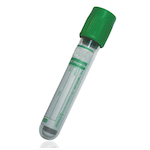Suitable Specimen Types
- Serum
- Li Hep Plasma
Specimen Transport
First Class PostSample Processing in Laboratory
Usual.Turnaround Time
1 weekSample Stability
Not statedCystatin C
General Information
Cystatin C is a small protein that is produced by nucleated cells. It is produced at a constant rate and is found in a variety of body fluids such as serum, spinal fluid, and breast milk. Cystatin C is filtered out of the blood by the glomerulus. Currently not routinely available but in the future, may serve as an alternative to creatinine to monitor kidney function in those with known or suspected kidney diseases.
It may be especially useful in detecting early decreases in kidney function (as measured by GFR) and in those for which creatinine measurement is a problem: for instance in those who have liver cirrhosis, are very obese, malnourished or have a very small muscle mass. It may also have a role along with other tests, such as urine microalbumin to monitor kidney function over time in those with diseases such as diabetes.
An elevated serum Cystatin C indicates a low GFR and kidney dysfunction. Since Cystatin C is produced throughout the body at a constant rate and removed by glomerular filtration (and subsequently broken down in another part of the kidney), it should remain at a steady state in the blood if the kidneys are working efficiently and the GFR is normal. There are indications that Cystatin C may also be elevated in cancer and rheumatic diseases, even when kidney function is normal, and the concentration can be affected by some drugs: corticosteroids can increase levels, while cyclosporine can decrease them. The concentration of Cystatin C is not, however, generally affected by most drugs, by infections, diet, inflammation or by tumour burden. The concentration of Cystatin C does not appear to be affected by gender, age (except very young and old), or race.
Patient Preparation
None
Reference Range
0-28 Days: 0.80-2.30mg/L,
29Days-12Months: 0.70-1.50mg/L,
13Months-17Years: 0.50-1.30mg/L,
18Years-50Years: 0.56-0.98mg/L,
>50Years: 0.61-1.40mg/L
Source of Reference Range
Referral laboratorySpecifications
- EQA Scheme?: Yes
- EQA Status: UKNEQAS
